Tapping the Potential of Neglected and Underutilized Food Crops for Sustainable Nutrition Security in the Mountains of Pakistan and Nepal
Abstract
:1. Introduction
2. Methodology
3. Nutrition Security in the Mountains
4. Nutritional Importance of NUFCs
5. Production Trends and Consumption
6. Challenges to Production of NUFCs
6.1. Deteriorating Local Food Systems and Agro-Diversity
6.2. Changing Food Habits
6.3. Lack of Nutritional Knowledge
6.4. Policy Constraints
7. A Framework for Mainstreaming NUFCs for Sustainable Nutrition Security
8. Conclusions
- Mainstream NFUCs into policies and programs
- Document indigenous knowledge on NFUCs
- Ensure the availability of germplasm for NFUCs
- Provide incentives to farmers to cultivate NFUCs
- Create institutional mechanisms (market facilities, extension services, credit and ICTs)
- Raise awareness about the nutritional value of NFUCs
- Support local food chains and establish a local processing industry
- Link NFUCs with tourism and school feeding programs
Acknowledgments
Author Contributions
Conflicts of Interest
References
- Keding, G.B.; Msuya, J.M.; Maass, B.L.; Krawinkel, M.B. Relating Dietary Diversity and Food Variety Scores to Vegetable Production and Socioeconomic Status of Women. Food Secur. 2012, 4, 129–140. [Google Scholar] [CrossRef]
- Hussain, A.; Zulfiqar, F.; Saboor, A. Changing Food Patterns across the Seasons in Rural Pakistan: Analysis of Food Variety, Dietary Diversity and Calorie Intake. Ecol. Food Nutr. 2014, 53, 119–141. [Google Scholar] [CrossRef] [PubMed]
- Underwood, B.A. Overcoming micronutrient deficiencies in developing countries: Is there a role for agriculture. Food Nutr. Bull. 2000, 21, 356–360. [Google Scholar] [CrossRef]
- World Health Organization; World Food Programme; United Nations Children’s Fund. Preventing and Controlling Micronutrient Deficiencies in Populations Affected by an Emergency; The World Health Organization: Geneva, Switzerland; The World Food Programme: Rome, Italy; The United Nations Children’s Fund: New York, NY, USA, 2007. [Google Scholar]
- NNS-GoP. National Nutrition Survey 2011; Planning Commission/Planning and Development Division: Islamabad, Pakistan, 2011. [Google Scholar]
- National Institute of Population Studies (Pakistan); ICF Internationl (USA). Demographic and Health Survey 2012–2013; National Institute of Population Studies (NIPS): Islamabad, Pakistan; ICF International: San Francisco, CA, USA; USAID: Islamabad, Pakistan, 2013.
- Mininstry of Health and Population (Nepal); New ERA; ICF International. Nepal Demographic and Health Survey; Ministry of Health and Population: Kathmandu, Nepal; New ERA: Kathmandu, Nepal; USAID: Islamabad, Pakistan, 2011.
- Government of Nepal. Nepal Thematic Report on Food Security and Nutrition 2013; National Planning Commission, Central Bureau of Statistics: Kathmandu, Nepal; World Food Program: Rome, Italy; World Bank: Washington, DC, USA; AusAID: Canberra, Australia; UNICEF: New York, NY, USA, 2013.
- Food and Agriculture Organization (FAO). Food for All Report of the World Food Summit; Food and Agriculture Organization (FAO): Rome, Italy, 1996. [Google Scholar]
- Food and Agriculture Organization (FAO). FAO and Traditional Knowledge: The Linkages with Sustainability, Food Security and Climate Change Impacts; Food and Agriculture Organization (FAO): Rome, Italy, 2009. [Google Scholar]
- Sah, R. Improving Food Security and Livelihood of Mountain People through Development of Agriculture; Agriculture Research Station: Lumle, Nepal, 2002. [Google Scholar]
- Padulosi, S.; Bergamini, N.; Lawrence, T. (Eds.) On-Farm Conservation of Neglected and Underutilized Species: Status, Trends and Novel Approaches to Cope with Climate Change. In Proceedings of the International Conference, Friedrichsdrof, Frankfurt, Germany, 14–16 June 2011; Biodiversity International: Rome, Italy, 2012.
- Gopalan, C.; Sastri, B.V.; Balasubramanian, S.C. Nutritive Value of Indian Foods; National Institute of Nutrition, Indian Council of Medical Research: Hyderabad, India, 1989. [Google Scholar]
- Schmidt, M.; Lam, N.T.; Hoanh, M.T.; Padulosi, S. Promoting Neglected and Underutilized Tuberous Plant Species in Vietnam. In Looking East Looking West: Organic and Quality Food Marketing in Asia and Europe; Haas, R., Canavari, M., Slee, B., Tong, C., Anurugsa, B., Eds.; Wageningen Academic Publishers: Wageningen, The Netherlands, 2010; pp. 183–194. [Google Scholar]
- Padulosi, S.; Hodgkin, T.; Williams, J.T.; Haq, N. Underutilized Crops: Trends, Challenges and Opportunities in the 21st Century. In Managing Plant Genetic Resources; Engels, J.M.M., Ramanatha, R.V., Brown, A.H.D., Jackson, M.T., Eds.; CABI Publishing: Wallingford, UK; IPGRI (International Plant Genetic Resources Institute): Rome, Italy, 2002; pp. 323–338. [Google Scholar]
- Gruere, G.P.; Smale, M.; Giuliani, A. Marketing underutilized plant species for the poor: A conceptual framework. In Agrobiodiversity, Conservation and Economic Development; Kontoleon, A., Pascual, U., Smale, M., Eds.; Routledge: London, UK; New York, NY, USA, 2006; pp. 62–81. [Google Scholar]
- Frison, E.A.; Smith, I.F.; Johns, T.; Cherfas, J.; Eyzaguirre, P.B. Agricultural Biodiversity, Nutrition and Health: Making a Difference to Hunger and Nutrition in the Developing World. Food Nutr. Bull. 2006, 27, 167–179. [Google Scholar] [CrossRef] [PubMed]
- Hawtin, G. Underutilized Plant Species Research and Development Activities-Review of Issues and Options; International Plant Genetic Resources Institute: Rome, Italy, 2007. [Google Scholar]
- Erlund, I.; Koli, R.; Alfthan, G.; Marniemi, J.; Puukka, P.; Mustonen, P.; Mattila, P.; Jula, A. Favourable Effects of Berry Consumption on Platelet Function, Blood Pressure, and HDL Cholesterol. Am. J. Clin. Nutr. 2008, 87, 323–331. [Google Scholar] [PubMed]
- Mwangi, S.; Kimathi, M. African Leafy Vegetable Evolves from Underutilized Species to Commercial Cash Crop; Research Workshop on Collective Action and Market Access for Small Holders: Cali, Colombia, 2006. [Google Scholar]
- Chadha, M.L.; Oluoch, M.O. Healthy Diet Gardening Kit for Better Health and Income. Acta Horticult. 2007, 752, 581–583. [Google Scholar] [CrossRef]
- Joordan, D.P.S.; Akinnifesi, F.K.; Ham, C.; Ajayi, O.C. The Feasibility of Small Scale Fruit Processing Enterprises in South Africa. In Indigenous Fruits Trees in the Tropics: Domestication, Utilization and Commercialization; Akinnifesi, F.K., Leakey, R.B.R., Ajayi, O.C., Sileshi, G., Tchoundjeu, Z., Matakala, P., Kwesiga, F.R., Eds.; World Agroforestry Center, Nairobi, Kenya and CAB International Publishing: Wallingford, UK, 2007. [Google Scholar]
- Hughes, J. Just Famine Foods? What Contribution can Underutilized Plants Make to Food Security? Acta Horticult. 2009, 806, 39–47. [Google Scholar] [CrossRef]
- Mahyao, A.; Kouame, C.; Agbo, E.; N’zi, J.C.; Fondio, L.; Van Damme, P. Socio Economic Importance of Urban Market Supply Chains of Indigenous Leafy Vegetables in Cote d’lvoire. Acta Horticult. 2009, 806, 489–496. [Google Scholar] [CrossRef]
- Padulosi, S.; Heywood, V.; Hunter, D.; Jarvis, A. Underutilized Species and Climate Change: Current Status and Outlook. In Crop Adaptation to Climate Change; Yadav, S.S., Redden, R., Hatfield, J.L., Lotze-Campen, H., Hall, A., Eds.; Blackwell Publishing Ltd.: Oxford, UK, 2011; pp. 507–521. [Google Scholar]
- Padulosi, S.; Hoeschle-Zeledon, I. Underutilized Plant Species: What are They? Leisa-Leusden 2004, 20, 5–6. [Google Scholar]
- Chivenge, P.; Mabhaudhi, T.; Modi, A.T.; Mafongoya, P. The Potential Role of Neglected and Underutilised Crop Species as Future Crops under Water Scarce Conditions in Sub-Saharan Africa. Int. J. Environ. Res. Public Health 2015, 12, 5685–5711. [Google Scholar] [CrossRef] [PubMed]
- Merrey, D.J.; Hussain, A.; Tamang, D.; Thapa, B. High Altitude Livelihoods and Climate Change: Insights from Rasuwa District, Nepal; HIAWARE Initiative of ICIMOD: Kathmandu, Nepal, 2017; unpublished. [Google Scholar]
- International Centre for Integrated Mountain Development (ICIMOD). Food Security in the Hindu Kush Himalayan Region; Position Paper; ICIMOD: Kathmandu, Nepal, 2008. [Google Scholar]
- Partap, T. High Value Cash Crops in Mountain Farming: Mountain Development Processes and Opportunities; ICIMOD: Kathmandu, Nepal, 1995. [Google Scholar]
- Tulachan, P.M. Mountain Agriculture in the Hindu-Kush Himalaya: A Regional Comparative Analysis. Mt. Res. Dev. 2001, 21, 260–267. [Google Scholar] [CrossRef]
- Kurvits, T.; Kaltenborn, B.; Nischalke, S.; Karky, B.; Jurek, M.; Tor Aase, T.H. The Last Straw: Food Security in the Hindu Kush Himalayas and the Additional Burden of Climate Change; CICERO: Oslo, Norway; Grid-Arendal: Arendal, Norway; ICIMOD: Kathmandu, Nepal, 2014. [Google Scholar]
- Basra, S.M.A. Quinoa in Pakistan: A case study. In Proceedings of the International Quinoa Conference 2016: Quinoa for Future Food and Nutrition Security in Marginal Environments, Dubai, UAE, 6–8 December 2016.
- Giuliani, A.; Karagoz, A.; Zencirci, N. Emmer (Triticum dicoccon) production and market potential in marginal mountainous areas of Turkey. Mt. Res. Dev. 2009, 29, 220–229. [Google Scholar] [CrossRef]
- Rasul, G.; Hussain, A.; Khan, M.A.; Ahmad, F.; Jasra, A.W. Towards a Framework for Achieving Food Security in the Mountains of Pakistan; ICIMOD Working Paper 2014/5; ICIMOD: Kathmandu, Nepal, 2014. [Google Scholar]
- Kassam, K.A.; Karamkhudoeva, M.; Ruelle, M.; Baumflek, M. Medicinal plant use and health sovereignty: Findings from the Tajik and Afghan Pamirs. Hum. Ecol. 2010, 38, 817–829. [Google Scholar] [CrossRef] [PubMed]
- Agricultural Statistics of Pakistan. Agricultural Statistics of Pakistan 2011–2012; Ministry of National Food Security and Research (Economics Wing), Government of Pakistan: Islamabad, Pakistan, 2012.
- Ministry of Gricultural Development. Statistical Information on Nepalese Agriculture 2013–2014; Agri-Business Promotion and Statistics Division, Agriculture Statistics Section, Ministry of Agricultural Development: Kathmandu, Nepal, 2014.
- Government of Nepal (GoN). National Population and Housing Census 2011; Central Bureau of Statistics/National Planning Commission Secretariat: Kathmandu, Nepal, 2012.
- Sustainable Development Policy Institute; Swiss Agency for Development and Cooperation; World Food Programme. Food Insecurity in Pakistan; Food Security Analysis 2009; Sustainable Development Policy Institute: Islamabd, Pakistan; Swiss Agency for Development and Cooperation: Bern, Switzerland; World Food Programme: Islamaad, Pakistan, 2009. [Google Scholar]
- Ghosh-Jerath, S.; Singh, A.; Kamboj, P.; Goldberg, G.; Magsumbol, M.S. Traditional Knowledge and Nutritive Value of Indigenous Foods in the Oraon Tribal Community of Jharkhand: An Exploratory Cross-Sectional Study. Ecol. Food Nutr. 2015, 54, 493–519. [Google Scholar] [CrossRef] [PubMed]
- Hussain, A. Food Security in Pakistan: Current Situation and Policy Issues at National and Regional Levels. Master’s Thesis, School of Environment, Resources and Development, Asian Institute of Technology, Khlong Nung, Thailand, 20 December 2009. [Google Scholar]
- Government of Nepal (GoN). Annual Household Survey 2014–2015; Central Bureau of Statistics, National Planning Commission Secretariat: Kathmandu, Nepal, 2016.
- Khalid, M.A.; Kaushik, G. Food Security in Mountains: Challenges and Sustainable Strategies. 2008. Available online: http://www.mtnforum.org/sites/default/files/publication/files/1850.pdf (accessed on 31 August 2016).
- Apetrei, C. Food Security and Millet Cultivation in Kumaon Region of Uttarakhand; A Research Report; Gene Compaign: New Delhi, India, 2012. [Google Scholar]
- Nagpal, S. Food Security in Hindu Kush Himalaya. Econ. Political Wkly. 1999, 34, 2717–2720. [Google Scholar]
- Fereres, E.; Orgaz, F.; Gonzalez-Dugo, V. Reflections on food security under water scarcity. J. Exp. Bot. 2011, 62, 4079–4086. [Google Scholar] [CrossRef] [PubMed]
- Mal, B.; Padulosi, S.; Ravi, S.B. Minor Millets in South Asia: Learnings from IFAD-NUS Project in India and Nepal; Biodiversity International, Maccarese: Rome, Italy; The M.S. Swaminathan Research Foundation: Chennai, India, 2010. [Google Scholar]
- Mayes, S.; Massawe, F.J.; Alderson, P.G.; Roberts, J.A.; Azam-Ali, S.N.; Hermann, M. The Potential for Underutilized Crops to Improve Security of Food Production. J. Exp. Bot. 2012, 63, 1075–1079. [Google Scholar] [CrossRef] [PubMed]
- Hunzai, K.; Gerlitz, J.Y.; Hoermann, B. Understanding mountain poverty in the Hindu Kush-Himalayas: Regional report for Afghanistan, Bangladesh, Bhutan, China, India, Myanmar, Nepal, and Pakistan; ICIMOD: Kathmandu, Nepal, 2011. [Google Scholar]
- Hussain, A.; Rasul, G.; Mahapatra, B.; Tuladhar, S. Household food security in the face of climate change in the Hindu-Kush Himalayan region. Food Secur. 2016, 8, 921–937. [Google Scholar] [CrossRef]
- Osei, A.; Pandey, P.; Spiro, D.; Nielson, J.; Shrestha, R.; Talukder, Z.; Quinn, V.; Haselow, N. Household Food Insecurity and Nutritional Status of Children Aged 6 to 23 Months in Kailali District of Nepal. Food Nut. Bull. 2010, 31, 483–494. [Google Scholar] [CrossRef]
- Regmi, A. (Ed.) Changing Structure of Global Food Consumption and Trade; Economic Research Service/USDA: Washington, DC, USA, 2011.
- Shively, G.; Thapa, G. Food PRICES, Their Determinants and Connections to Child Nutrition in Nepal; Nutrition Innovation Lab Research Brief No. 18; Feed the Future Innovation Lab: Boston, MA, USA, 2014; Available online: file:///C:/Users/ahussain/Downloads/16396.archival.pdf (accessed on 8 November 2016).
- Zulfiqar, F.; Hussain, A. Forecasting Wheat Production Gaps to Assess the State of Future Food Security in Pakistan. J. Food Nutr. Disord. 2014, 3, 1–6. [Google Scholar]
- Fassil, H.; Guarino, L.; Sharrock, S.; Mal, B.; Hodgkin, T.; Iwanaga, M. Diversity for Food Security: Improving Human Nutrition through Better Evaluation, Management, and Use of Plant Genetic Resources. Food Nutr. Bull. 2000, 21, 497–502. [Google Scholar] [CrossRef]
- Johns, T.; Sthapit, B.R. Biocultural Diversity in the Sustainability of Developing-Country Food Systems. Food Nutr. Bull. 2004, 25, 143–155. [Google Scholar] [CrossRef] [PubMed]
- Galluzzi, G.; Noriega, I.L. Conservation and Use of Genetic Resources of Underutilized Crops in the Americas—A Continental Analysis. Sustainability 2014, 6, 980–1017. [Google Scholar] [CrossRef]
- Hagen, T. Traditional Framing Practices and Farmers’ Rights in the HKH Region; Policy Brief. No. 6; SWATEE: Lalitpur, Nepal, 2004. [Google Scholar]
- Williams, J.T.; Haq, N. Global Research on Underutilized Crops. An Assessment of Current Activities and Proposals for Enhanced Cooperation; ICUC: Southampton, UK, 2002. [Google Scholar]
- Handschuch, C.; Wollni, M. Improved Production Systems for Traditional Food Crops: The Case of Finger Millet in Western Kenya. Food Secur. 2016, 8, 783–797. [Google Scholar] [CrossRef]
- Handschuch, C.; Wollni, M. Traditional food crop marketing in Sub-Saharan Africa: Does gender matter? J. Dev. Stud. 2016, 52, 343–359. [Google Scholar] [CrossRef]
- Oduori, C. The Importance and Research Status of Finger Millet in Africa. In Presented at the McKnight Foundation Collaborative Crop Research Program Workshop on Tef & Finger Millet: Comparative Genomics of the Chloridoid Cereals at the Biosciences for East and Central Africa (BECA), Nairobi, Kenya, 28–30 June 2005.
- Padulosi, S.; Mal, B.; King, O.I.; Gotar, E. Minor Millets as a Central Element for Sustainably Enhanced Incomes, Empowerment, and Nutrition in Rural India. Sustainability 2015, 7, 8904–8933. [Google Scholar] [CrossRef]
- Padulosi, S.; Amaya, K.; Jager, M.; Gotor, E.; Rojas, W.; Valdivia, R. Holistic Approach to Enhance the Use of Neglected and Underutilized Species: The Case of Andean Grains in Bolivia and Peru. Sustainability 2014, 6, 1283–1312. [Google Scholar] [CrossRef]
- Padulosi, S.; Mal, B.; Bala Ravi, S.; Gowda, J.; Gowda, K.T.K.; Shanthakumar, G.; Yenagi, N.; Dutta, M. Food Security and Climate Change: Role of Plant Genetic Resources of Minor Millets. Indian J. Plant Genet. Resour. 2009, 22, 1–16. [Google Scholar]
- Mal, B. Neglected and Underutilized Crop Genetic Resources for Sustainable Agriculture. Indian J. Plant Genet. Resour. 2007, 22, 1–16. [Google Scholar]
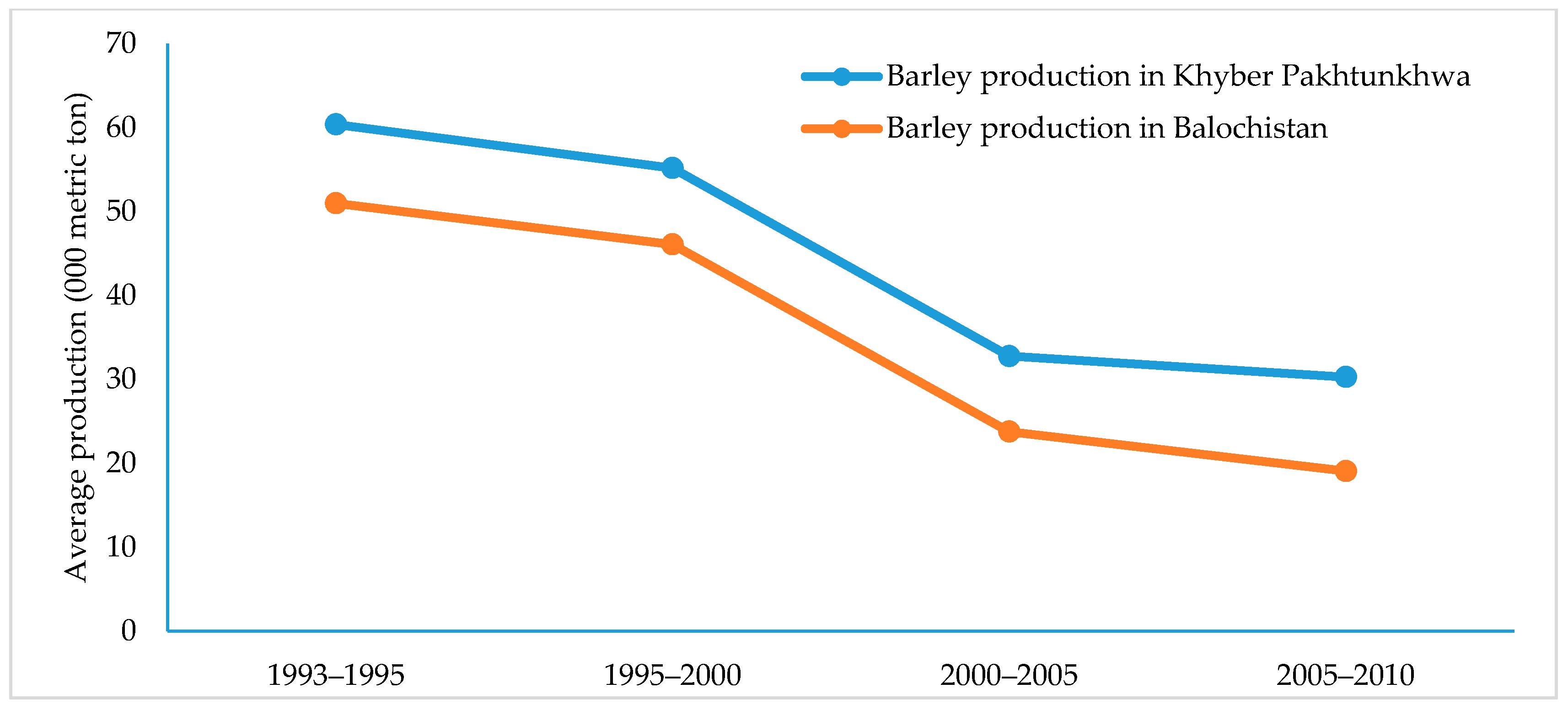
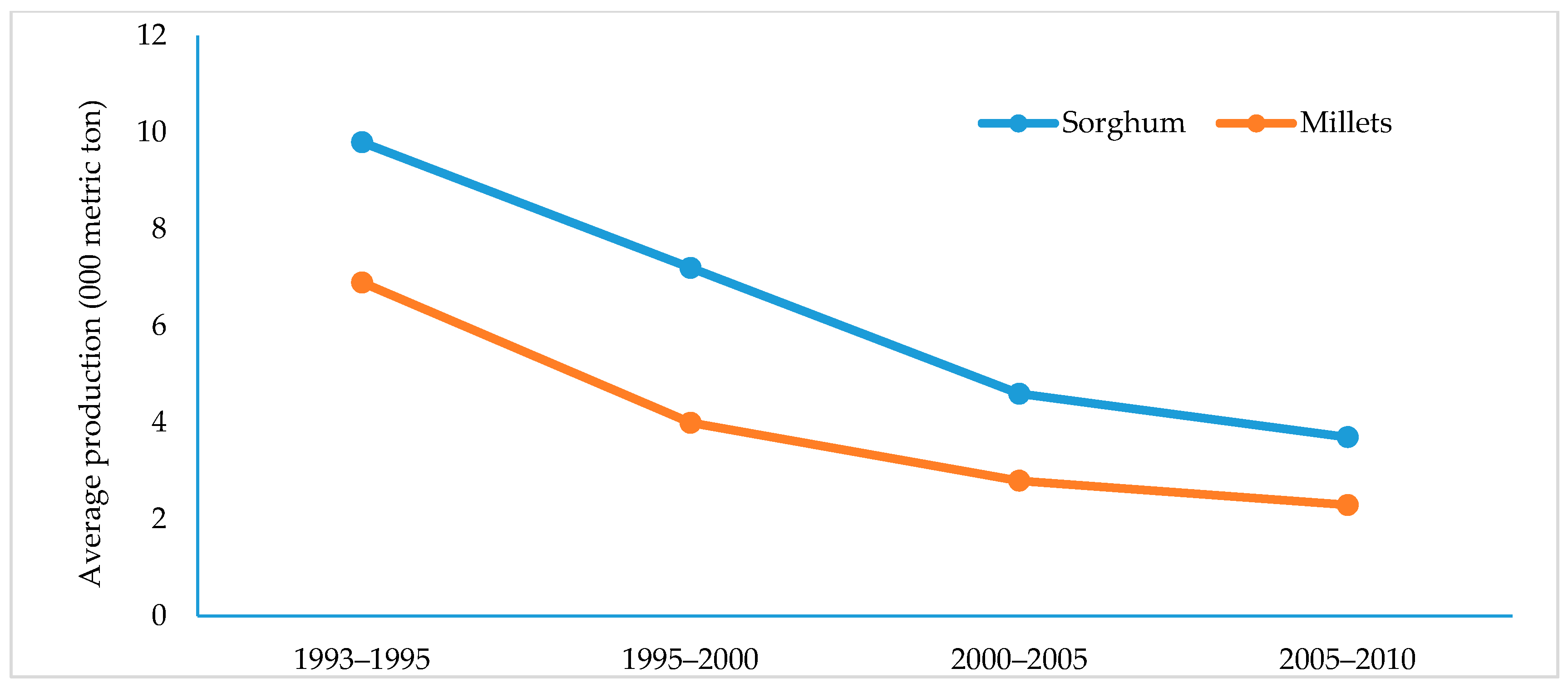
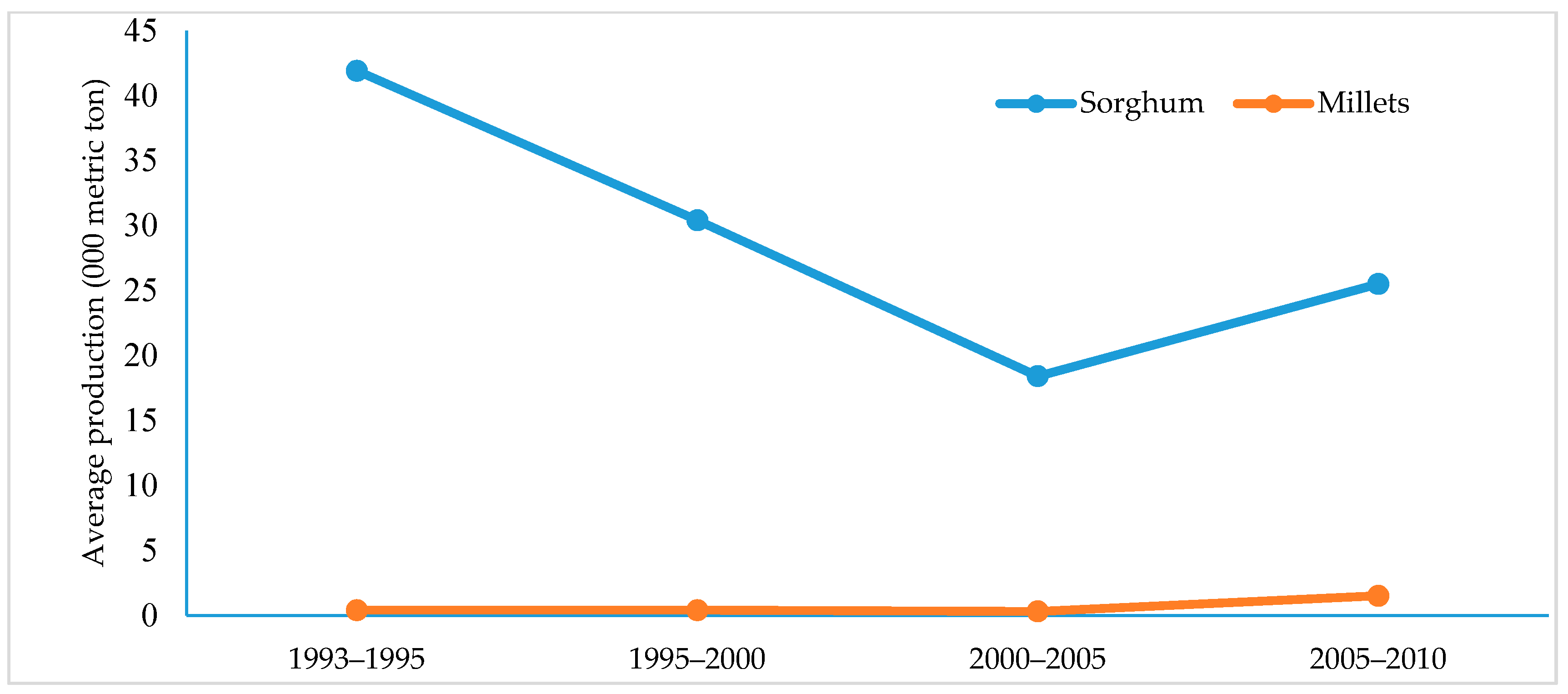
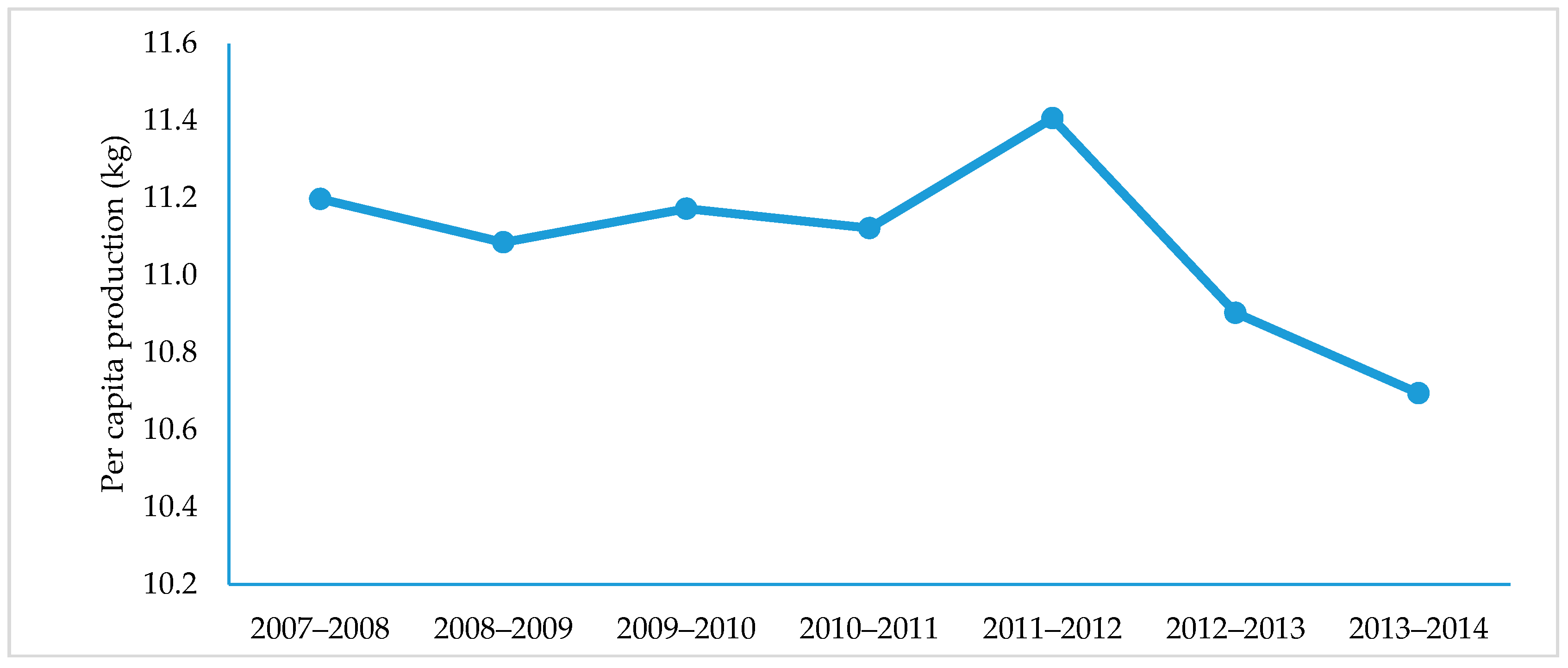
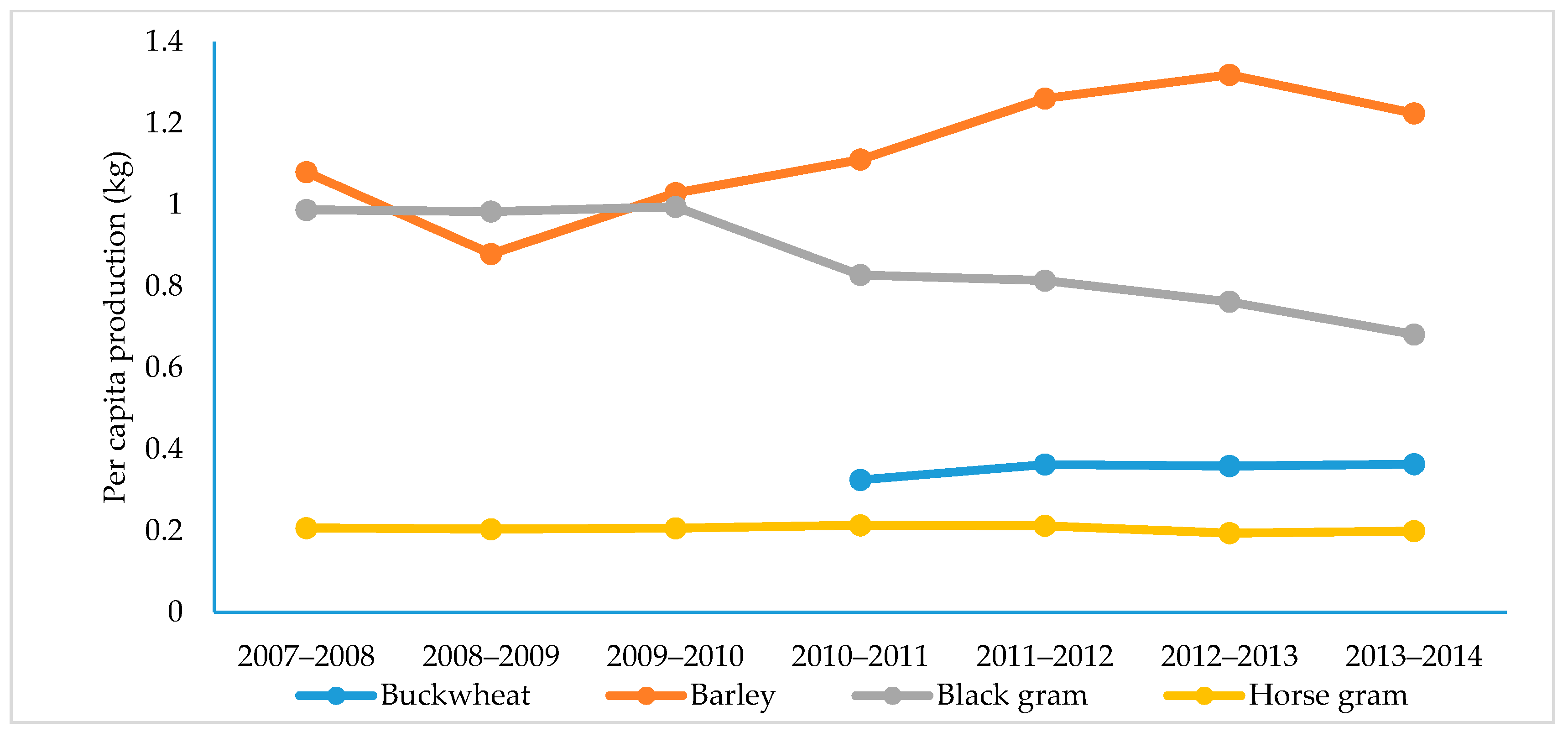
| Indicator | National Average (%) | Mountain Provinces | ||
|---|---|---|---|---|
| Balochistan (%) | Khyber Pakhtunkhwa (%) | |||
| Prevalence of food insecurity (%) * | 49 | 61 | 56 | |
| % of women (aged 15–49 year) ** with calcium deficiency | Non-pregnant women | 51 | 60 | 71 |
| Pregnant women | 58 | 63 | 61 | |
| % of children (aged < 5 year) with growth problems *** | Stunting 1 | 44.4 | 81.9 | 41.3 |
| Wasting 2 | 10.7 | 13.2 | 11.7 | |
| Underweight 3 | 29.4 | 37.4 | 25.3 | |
| Indicator | National Average (%) | Mountains (%) | Hills (%) |
|---|---|---|---|
| Food insecure households (%) | 50.8 | 59.5 | 52.8 |
| Prevalence of underweight women (aged 15–49 years) | 18.2 | 16.5 | 12.4 |
| Stunting * (%) | 40.5 | 52.9 | 42.1 |
| Wasting ** (%) | 10.9 | 10.9 | 10.6 |
| Underweight *** (%) | 28.8 | 35.9 | 26.6 |
| Nutrient | Some Examples of Traditional Food Crops (Content/100 g) | Advanced Cereals (Content/100 g) | ||||||||
|---|---|---|---|---|---|---|---|---|---|---|
| Pearl Millet | Sorghum | Finger Millet | Foxtail Millet | Proso Millet | Barnyard Millet | Kodo Millet | Rice (Milled) | Maize | Wheat Flour | |
| Energy (kcal) | 361 | 349 | 328 | 331 | 341 | 397 | 309 | 345 | 342 | 346 |
| Protein (g) | 11.6 | 10.4 | 7.3 | 12.3 | 7.7 | 6.2 | 8.3 | 6.8 | 11.1 | 12.1 |
| Fat (g) | 5.0 | 1.9 | 1.3 | 4.3 | 4.7 | 2.2 | 1.4 | 0.4 | 3.6 | 1.7 |
| Calcium (mg) | 42.0 | 25.0 | 344 | 31.0 | 17.0 | 20.0 | 27.0 | 10.0 | 10.0 | 48.0 |
| Iron (mg) | 8.0 | 4.1 | 3.9 | 2.8 | 9.3 | 5.0 | 0.5 | 3.2 | 2.3 | 4.9 |
| Zinc (mg) | 3.1 | 1.6 | 2.3 | 2.4 | 3.7 | 3.0 | 0.7 | 1.4 | 2.8 | 2.2 |
| Thiamine (mg) | 0.33 | 0.37 | 0.42 | 0.59 | 0.21 | 0.33 | 0.33 | 0.06 | 0.42 | 0.49 |
| Riboflavin (mg) | 0.25 | 0.13 | 0.19 | 0.11 | 0.01 | 0.10 | 0.09 | 0.06 | 0.10 | 0.17 |
| Folic acid (mg) | 45.5 | 20 | 18.3 | 15.0 | 9.0 | - | 23.1 | 8.0 | 20 | 36.6 |
| Fiber (g) | 1.2 | 1.6 | 3.6 | 8.0 | 7.6 | 9.8 | 9.0 | 0.2 | 2.7 | 1.2 |
| Year | Millets | Buckwheat | Barley | Black Gram | Horse Gram | Wheat | Rice | Maize | ||||||||
|---|---|---|---|---|---|---|---|---|---|---|---|---|---|---|---|---|
| NP (000 MT) | PCP (kg) | NP (000 MT) | PCP (kg) | NP (000 MT) | PCP (kg) | NP (000 MT) | PCP (kg) | NP (000 MT) | PCP (kg) | NP (000 MT) | PCP (kg) | NP (000 MT) | PCP (kg) | NP (000 MT) | PCP (kg) | |
| 2007/2008 | 291 | 11.198 | NA | NA | 28 | 1.080 | 26 | 0.988 | 5 | 0.207 | 1572 | 60 | 4299 | 165 | 1879 | 72 |
| 2008/2009 | 293 | 11.085 | NA | NA | 23 | 0.880 | 26 | 0.983 | 5 | 0.204 | 1344 | 51 | 4524 | 171 | 1931 | 73 |
| 2009/2010 | 299 | 11.172 | NA | NA | 28 | 1.029 | 27 | 0.995 | 6 | 0.206 | 1556 | 58 | 4024 | 150 | 1855 | 69 |
| 2010/2011 | 303 | 11.122 | 8841 | 0.325 | 30 | 1.111 | 22 | 0.828 | 6 | 0.213 | 1746 | 64 | 4460 | 164 | 2067 | 76 |
| 2011/2012 | 315 | 11.406 | 10,021 | 0.363 | 35 | 1.261 | 22 | 0.814 | 6 | 0.212 | 1846 | 67 | 5072 | 184 | 2179 | 79 |
| 2012/2013 | 306 | 10.903 | 10,056 | 0.359 | 37 | 1.319 | 21 | 0.762 | 5 | 0.194 | 1882 | 67 | 4504 | 161 | 1999 | 71 |
| 2013/2014 | 304 | 10.695 | 10,335 | 0.363 | 35 | 1.225 | 19 | 0.682 | 6 | 0.199 | 1883 | 66 | 5047 | 177 | 2283 | 80 |
| Creating an Enabling Environment (Policy Steps) | Suggested Option | Contribution of NUFCs to Strengthening Food Security Dimensions and Health | Contribution to Nutrition Security | Auxiliary Benefits | |
|---|---|---|---|---|---|
| Mainstream NFUCs into national and sub-national policies and programs Document and promote the use of existing indigenous knowledge on the cultivation and utilization of NUFCs Ensure the availability of germplasm for NFUCs Create interest in cultivating NFUCs among farmers through incentives Strengthen institutional mechanisms (market facilities, extension services, credit and ICTs) Create awareness among people about the nutritional value of NUFCs Support local food value chains and establish a local food processing industry for NUFCs Link NUFCs with tourism (guide local hotels/resorts in mountain areas to include NFUCs on their menus) Link NUFCs with school feeding programs |  | Food availability | Locally increased supply of food Improved diversity in available food | Reduced chances of growth problems in children (aged < 5 years), e.g., stunting, wasting and underweight Reduced prevalence of micronutrient deficiencies and anemia in children and women Reduced prevalence of underweight women (aged 15– 49 years) Expected reduction in number of individuals with low body mass index | Improved biodiversity in mountains Reduced agricultural investment needed Increased employment opportunities in mountains may lead to reduced outmigration rate Increased opportunities for ecotourism Improved odds of exporting food products (prepared from NUFCs) from mountains to other areas, leading to improved income in mountain regions |
| Food accessibility | Improved income for farmers Improved local income opportunities if local food processing industry is established Improved physical access to food due to local production of diverse foods | ||||
| Food utilization and health | Improved diversity in food intake Improved intake of micronutrients, conducive to better health Reduced health hazards (NUFCs require less chemical fertilizers and pesticides) | ||||
| Risks and uncertainties | NUFCs are highly climate resilient No risk of supply being cut due to natural hazards and economic factors because NUFCs are locally produced | ||||
© 2017 by the authors. Licensee MDPI, Basel, Switzerland. This article is an open access article distributed under the terms and conditions of the Creative Commons Attribution (CC BY) license ( http://creativecommons.org/licenses/by/4.0/).
Share and Cite
Adhikari, L.; Hussain, A.; Rasul, G. Tapping the Potential of Neglected and Underutilized Food Crops for Sustainable Nutrition Security in the Mountains of Pakistan and Nepal. Sustainability 2017, 9, 291. https://doi.org/10.3390/su9020291
Adhikari L, Hussain A, Rasul G. Tapping the Potential of Neglected and Underutilized Food Crops for Sustainable Nutrition Security in the Mountains of Pakistan and Nepal. Sustainability. 2017; 9(2):291. https://doi.org/10.3390/su9020291
Chicago/Turabian StyleAdhikari, Lipy, Abid Hussain, and Golam Rasul. 2017. "Tapping the Potential of Neglected and Underutilized Food Crops for Sustainable Nutrition Security in the Mountains of Pakistan and Nepal" Sustainability 9, no. 2: 291. https://doi.org/10.3390/su9020291
APA StyleAdhikari, L., Hussain, A., & Rasul, G. (2017). Tapping the Potential of Neglected and Underutilized Food Crops for Sustainable Nutrition Security in the Mountains of Pakistan and Nepal. Sustainability, 9(2), 291. https://doi.org/10.3390/su9020291






